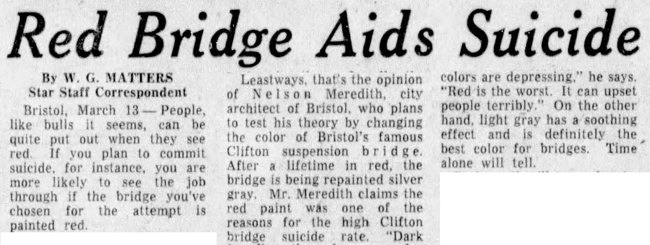Bridge Color and Suicide
There's a popular hypothesis that the color of a bridge can influence how many people commit suicide from it. Dark bridges are said to attract more jumpers than brightly colored ones.
The most widely cited example of this effect is Blackfriars Bridge in London. It originally was black, but in 1928 it was repainted green with yellow trim. In fact, it was repainted with the specific intention of reducing suicide attempts. And sure enough, the suicide rate reportedly dropped by 30%. (More info: "The influence of color," Penn State)
Blackfriars Bridge is no longer green, but it's still brightly painted (red and white). I can't find info on how many people still jump from it. So I don't know if the color effect is still working.


Another example is the Clifton Suspension Bridge near Bristol, England. In 1957 its color was changed from dark red to a light silver-gray — again with the specific hope of deterring suicide jumpers. Unfortunately I can't find any follow-up data to know if the color change worked.


The connection between bridge color and suicide seems a bit dubious to me. It would be nice if there was more substantial data to back up the hypothesis.
The most widely cited example of this effect is Blackfriars Bridge in London. It originally was black, but in 1928 it was repainted green with yellow trim. In fact, it was repainted with the specific intention of reducing suicide attempts. And sure enough, the suicide rate reportedly dropped by 30%. (More info: "The influence of color," Penn State)
Blackfriars Bridge is no longer green, but it's still brightly painted (red and white). I can't find info on how many people still jump from it. So I don't know if the color effect is still working.

Yonkers Herald Statesman - Sep 15, 1928

Blackfriars Bridge (source: wikipedia)
Another example is the Clifton Suspension Bridge near Bristol, England. In 1957 its color was changed from dark red to a light silver-gray — again with the specific hope of deterring suicide jumpers. Unfortunately I can't find any follow-up data to know if the color change worked.

Toronto Daily Star - Mar 13, 1957

Clifton Suspension Bridge (source: wikipedia)
The connection between bridge color and suicide seems a bit dubious to me. It would be nice if there was more substantial data to back up the hypothesis.
Comments
The dark red that the Bristol city architech claims is the very worst for attracting jumpers sounds just like the color the Golden Gate Bridge has always been. Apparently, there isn't widespread acceptance of this concept.
A friend of mine living in Sausalito thinks it should be painted gold. This should help his argument.
A friend of mine living in Sausalito thinks it should be painted gold. This should help his argument.
Posted by Virtual on 11/03/23 at 05:29 PM
Well, except that the Golden Gate Bridge is not dark red but a quite bright orange-red.
Posted by Richard Bos on 11/04/23 at 06:23 AM
Well, I can only speak for the San Francisco and Sausalito where I lived. Perhaps there are some parallel universes around. True, it's not the darkest possible red, but it's pretty lame to take issue with that.
Posted by Virtual on 11/04/23 at 07:29 AM
Commenting is not available in this channel entry.

Category: Architecture | Suicide